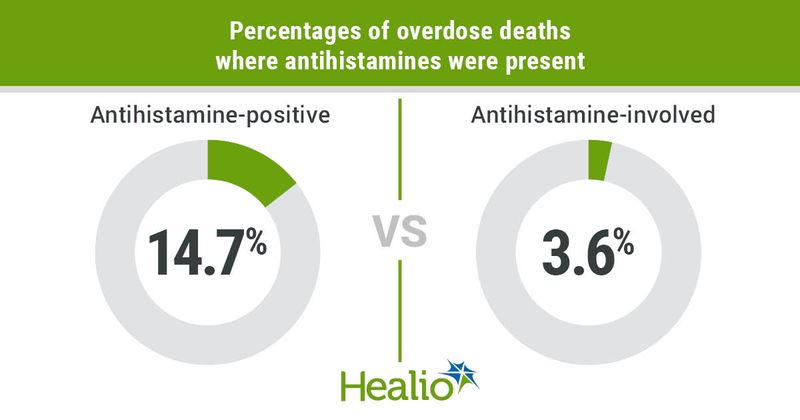Antihistamines present in some opioid overdoses, deaths
Click Here to Manage Email Alerts
As drug overdose deaths grab headlines in the U.S., 14.7% of these deaths were positive for antihistamines and 3.6% of them were classified as antihistamine-involved, according to data published in Morbidity and Mortality Weekly Report.
“Analyses were prompted by initial findings in CDC’s State Unintentional Drug Overdose Reporting System (SUDORS) data, which showed some unintentional and undetermined intent overdose deaths co-involved opioids and diphenhydramine, a sedating antihistamine,” Amanda T. Dinwiddie, MPH, division of overdose prevention, National Center for Injury Prevention and Control at the CDC, told Healio.


First-generation H1 antihistamines cause strong sedation and other anticholinergic effects that may be exacerbated when they are used with opioids and other sedatives, the researchers wrote.
Also, dealers of illegal drugs combine the common, over-the-counter, first-generation H1 antihistamine diphenhydramine with opioids as an adulterant in their supplies to reduce side effects such as itchy skin related to opioid use.
The researchers used SUDORS to analyze 2019 to 2020 data collected from 43 states and the District of Columbia. They defined deaths as antihistamine-positive if any antihistamine was detected via postmortem toxicology or if it was listed as a cause of death on the death certificate. Also, the researchers defined deaths as antihistamine-involved if the death certificate listed the drug class as a cause of death.
With a total of 92,033 overdose deaths, the researchers found 13,574 (14.7%) that were antihistamine-positive and 3,345 (3.6%) that were antihistamine-involved. Additionally, 90 (< 0.1%) involved antihistamines alone.
Also, 99.6% of the antihistamine-positive deaths and 99.8% of the antihistamine-involved deaths included first-generation H1 antihistamines, primarily diphenhydramine (71.1% and 66.5%).
The highest proportions of antihistamine- and diphenhydramine-involved deaths included females (52% and 52.8%), people aged 35 to 44 years (26.1% and 26.5%) and white, non-Hispanic people (78.1% and 78.7%). The highest proportions of antihistamine- and diphenhydramine-positive deaths included males (57.8% and 59.6%) and people from the Midwest (43.6% and 51%).
Opioids, primarily illicitly manufactured fentanyl, were co-involved in 82.8% of the antihistamine-positive deaths and 82.7% of the diphenhydramine-involved deaths.
“Many (more than 50%) antihistamine-involved overdose deaths also involved illicitly manufactured fentanyls,” Dinwiddie said.
In addition to their sedative effects, the researchers said, antihistamines are dangerous when they are mixed with opioids because they do not respond to naloxone, an FDA-approved medication administered to rapidly reverse opioid overdose.
“Naloxone administration is important for any overdose with suspected opioid involvement. Because antihistamines do not respond to naloxone, co-involved opioid and antihistamine overdoses might require other immediate medical response measures in addition to naloxone administration to prevent death,” Dinwiddie said.
“It is also important to encourage people who use drugs not to use alone and encourage friends and families of people who use drugs to recognize the signs and symptoms of overdose and ensure they know how to use naloxone,” she continued.
The researchers cautioned that their results only included 44 jurisdictions and may not be nationally representative. They also noted that these jurisdictions do not use standardized drug testing methods, which may limit interpretation of these results.
Further, the researchers clarified that positivity could reflect the use of antihistamines to treat allergy or other symptoms and not misuse. Or, the researchers continued, users may not have knowingly consumed antihistamines that were used to adulterate the illicit drug supply.
Yet the researchers concluded that these findings underscored the importance of continued surveillance in understanding how antihistamines contribute to overdose deaths and in guiding awareness about their potential dangers.
Although no follow-up studies are planned at this time, Dinwiddie said that the CDC will continue to monitor drug overdose deaths and support the administration of naloxone as an important response measure for any overdose with suspected opioid involvement.
“Because most overdose deaths involve opioids, many of which involve highly potent fentanyl, it is also important to expand distribution and training on fentanyl test strips, which can identify the presence of fentanyl in drugs,” she said.
“Finally, and most importantly, immediate medical attention (eg, calling 911) should be sought for anyone with a suspected or known overdose,” she said.

